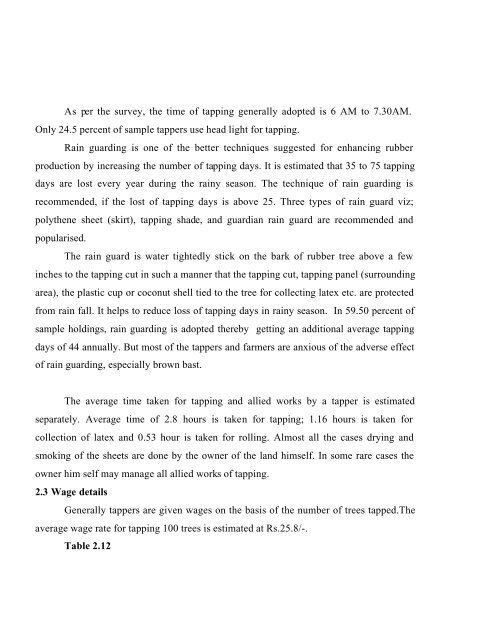socio-economic profile of rubber tappers in the small holding sector
socio-economic profile of rubber tappers in the small holding sector
socio-economic profile of rubber tappers in the small holding sector
Create successful ePaper yourself
Turn your PDF publications into a flip-book with our unique Google optimized e-Paper software.
As per <strong>the</strong> survey, <strong>the</strong> time <strong>of</strong> tapp<strong>in</strong>g generally adopted is 6 AM to 7.30AM.<br />
Only 24.5 percent <strong>of</strong> sample <strong>tappers</strong> use head light for tapp<strong>in</strong>g.<br />
Ra<strong>in</strong> guard<strong>in</strong>g is one <strong>of</strong> <strong>the</strong> better techniques suggested for enhanc<strong>in</strong>g <strong>rubber</strong><br />
production by <strong>in</strong>creas<strong>in</strong>g <strong>the</strong> number <strong>of</strong> tapp<strong>in</strong>g days. It is estimated that 35 to 75 tapp<strong>in</strong>g<br />
days are lost every year dur<strong>in</strong>g <strong>the</strong> ra<strong>in</strong>y season. The technique <strong>of</strong> ra<strong>in</strong> guard<strong>in</strong>g is<br />
recommended, if <strong>the</strong> lost <strong>of</strong> tapp<strong>in</strong>g days is above 25. Three types <strong>of</strong> ra<strong>in</strong> guard viz;<br />
poly<strong>the</strong>ne sheet (skirt), tapp<strong>in</strong>g shade, and guardian ra<strong>in</strong> guard are recommended and<br />
popularised.<br />
The ra<strong>in</strong> guard is water tightedly stick on <strong>the</strong> bark <strong>of</strong> <strong>rubber</strong> tree above a few<br />
<strong>in</strong>ches to <strong>the</strong> tapp<strong>in</strong>g cut <strong>in</strong> such a manner that <strong>the</strong> tapp<strong>in</strong>g cut, tapp<strong>in</strong>g panel (surround<strong>in</strong>g<br />
area), <strong>the</strong> plastic cup or coconut shell tied to <strong>the</strong> tree for collect<strong>in</strong>g latex etc. are protected<br />
from ra<strong>in</strong> fall. It helps to reduce loss <strong>of</strong> tapp<strong>in</strong>g days <strong>in</strong> ra<strong>in</strong>y season. In 59.50 percent <strong>of</strong><br />
sample hold<strong>in</strong>gs, ra<strong>in</strong> guard<strong>in</strong>g is adopted <strong>the</strong>reby gett<strong>in</strong>g an additional average tapp<strong>in</strong>g<br />
days <strong>of</strong> 44 annually. But most <strong>of</strong> <strong>the</strong> <strong>tappers</strong> and farmers are anxious <strong>of</strong> <strong>the</strong> adverse effect<br />
<strong>of</strong> ra<strong>in</strong> guard<strong>in</strong>g, especially brown bast.<br />
The average time taken for tapp<strong>in</strong>g and allied works by a tapper is estimated<br />
separately. Average time <strong>of</strong> 2.8 hours is taken for tapp<strong>in</strong>g; 1.16 hours is taken for<br />
collection <strong>of</strong> latex and 0.53 hour is taken for roll<strong>in</strong>g. Almost all <strong>the</strong> cases dry<strong>in</strong>g and<br />
smok<strong>in</strong>g <strong>of</strong> <strong>the</strong> sheets are done by <strong>the</strong> owner <strong>of</strong> <strong>the</strong> land himself. In some rare cases <strong>the</strong><br />
owner him self may manage all allied works <strong>of</strong> tapp<strong>in</strong>g.<br />
2.3 Wage details<br />
Generally <strong>tappers</strong> are given wages on <strong>the</strong> basis <strong>of</strong> <strong>the</strong> number <strong>of</strong> trees tapped.The<br />
average wage rate for tapp<strong>in</strong>g 100 trees is estimated at Rs.25.8/-.<br />
Table 2.12










